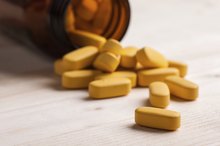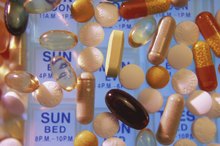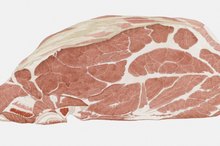Ingredients of Vitamin C Tablets
Vitamin C, also called ascorbic acid, is a naturally occurring vitamin that you need for a number of bodily functions. Vitamin C is important for bone, muscle, cartilage and vascular health. It is also an important component of regulating iron metabolism, which is necessary for red blood cells to carry oxygen to all of the cells and tissues of your body. Your body is not capable of producing vitamin C on its own, so you must make sure that you are getting enough of it from your nutrition in the form of fruits and vegetables that are naturally rich in this vitamin, like oranges, pineapples and broccoli. Alternatively, you may supplement your diet with vitamin C pills or tablets. When considering the use of vitamin supplements, you should be aware of all ingredients to ensure that you are not taking something that you may be allergic to or that will negatively interact with other medications you might be taking.
Ascorbic Acid
While particular formulations of vitamin C tablets may differ slightly among competing manufacturers’, the primary ingredient should be raw ascorbic acid. Vitamin C tablet makers utilize raw ascorbic acid that is either extracted from plants like corn, or chemically synthesized. The ascorbic acid derived from these sources is exactly the same chemically, although people with allergies may need to be aware of the plant sources used in food-derived ascorbic acid products as these tablets may contain small amounts of foods to which they are allergic. Some vitamin C supplements do not have ascorbic acid as the primary ingredient. These are marketed as special vitamins, which may tout extra benefits over a normal vitamin C supplement, or the product may be a multivitamin tablet that includes vitamin C among other nutrients.
- While particular formulations of vitamin C tablets may differ slightly among competing manufacturers’, the primary ingredient should be raw ascorbic acid.
Filler Ingredients
Vitamin D2 Dangers
Learn More
In addition to the primary ingredient, benign filler chemicals are added to the mixture to serve as binding, coating and lubricating agents. Depending upon the manufacturer, the exact proportions and types of fillers that are used may vary slightly; however, most of these ingredients are identical or similarly classified. These may include vegetable or magnesium stearate, methylcellulose, glycerol and silica. These agents are considered non-active ingredients and are not expected to have any negative or positive impact on your health.
- In addition to the primary ingredient, benign filler chemicals are added to the mixture to serve as binding, coating and lubricating agents.
Cellulose Coating
Besides the active and inactive filler ingredients, a cellulose coating is often applied to the exterior of your vitamin C tablet. This coating may either delay the release of active ingredients or reduce undesirable flavors. Alternatively, you could purchase vitamin C supplements that do not have an exterior coating -- these are often formulated to be chewable.
Related Articles
References
- Drugs.com: Vitamin C
- University of Maryland Medical Center: Vitamin C
- ConsumerLab.com: Vitamin C Supplements
- Slatore CG, Littman AJ, Au DH, Satia JA, White E. Long-term use of supplemental multivitamins, vitamin C, vitamin E, and folate does not reduce the risk of lung cancer. Am J Respir Crit Care Med. 2008;177(5):524-30. doi:10.1164/rccm.200709-1398OC
- NIH Office of Dietary Supplements. Vitamin C. Updated December 10, 2019.
- Schleicher RL, Carroll MD, Ford ES, Lacher DA. Serum vitamin C and the prevalence of vitamin C deficiency in the United States: 2003-2004 National Health and Nutrition Examination Survey (NHANES). Am J Clin Nutr. 2009;90(5):1252-63. doi:10.3945/ajcn.2008.27016
- Quinn J, Gerber B, Fouche R, Kenyon K, Blom Z, Muthukanagaraj P. Effect of high-dose vitamin C infusion in a glucose-6-phosphate dehydrogenase-deficient patient. Case Rep Med. 2017;2017:5202606. doi:10.1155/2017/5202606
- Douglas RM, Hemilä H, Chalker E, Treacy B. Vitamin C for preventing and treating the common cold. Cochrane Database Syst Rev. 2007;(3):CD000980. doi:10.1002/14651858.CD000980.pub3
- Hemilä H, Chalker E. Vitamin C for preventing and treating the common cold. Cochrane Database Syst Rev. 2013;(1):CD000980. doi:10.1002/14651858.CD000980.pub4
- A randomized, placebo-controlled, clinical trial of high-dose supplementation with vitamins C and E, beta carotene, and zinc for age-related macular degeneration and vision loss: AREDS report no. 8. Arch Ophthalmol. 2001;119(10):1417-36. doi:10.1001/archopht.119.10.1417
- Weikel KA, Garber C, Baburins A, Taylor A. Nutritional modulation of cataract. Nutr Rev. 2014;72(1):30-47. doi:10.1111/nure.12077
- Juraschek SP, Guallar E, Appel LJ, Miller ER. Effects of vitamin C supplementation on blood pressure: a meta-analysis of randomized controlled trials. Am J Clin Nutr. 2012;95(5):1079-88. doi:10.3945/ajcn.111.027995
- Sesso HD, Buring JE, Christen WG, et al. Vitamins E and C in the prevention of cardiovascular disease in men: the Physicians' Health Study II randomized controlled trial. JAMA. 2008;300(18):2123-33. doi:10.1001/jama.2008.600
- Lin J, Cook NR, Albert C, et al. Vitamins C and E and beta carotene supplementation and cancer risk: a randomized controlled trial. J Natl Cancer Inst. 2009;101(1):14-23. doi:10.1093/jnci/djn438
- Slatore CG, Littman AJ, Au DH, Satia JA, White E. Long-term use of supplemental multivitamins, vitamin C, vitamin E, and folate does not reduce the risk of lung cancer. Am J Respir Crit Care Med. 2008;177(5):524-30. doi:10.1164/rccm.200709-1398OC
Writer Bio
Chris Bjorklund has been writing professionally since 2004 and has been primarily featured in peer-reviewed scientific journals such as "Nucleic Acids Research" and "Biochemistry." He has also been anonymously published as a content freelancer for several websites. He completed his doctoral degree in biochemistry at Washington State University in 2006.









